Employee Voice – Protections and Restraints
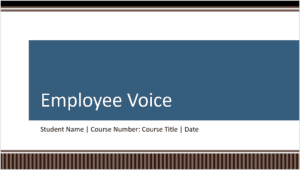
Hello, everyone. Welcome to this presentation on employee voice and the important aspects pertaining to employee voice.
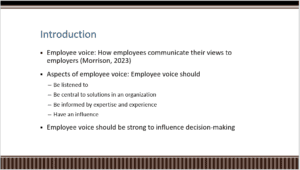
Employee voice is an important aspect of human resource management. According to Morrison (2023), employee voice refers to the way employees communicate their views to their employers. An organizational setting should entail an environment where employees are considered to be part of the solution and not the problem. As a result, the voice of employees should be invited to assist in finding solutions; the voice should be respected. Employees’ voices should be informed by their experience, ideas, and expertise. It is important for employee voice to be strong to ensure that managers recognize its importance and acknowledge it.
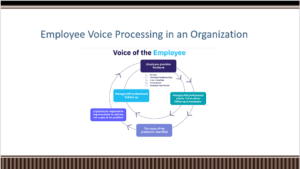
Employee voice is processed as indicated in the figure shown. First, an employee provides feedback through the various avenues provided for channeling feedback. The channels can be surveys or one-on-one meetings. Once the manager obtains the feedback, an assessment is made on whether follow-up should be done immediately for the feedback provided. An actual follow-up on the issue raised is conducted. Based on the discoveries, the cause of the problem is identified. The problem and its cause are addressed through the implementation of measures to improve the situation and eliminate the cause of the problem.
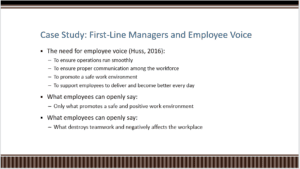
Line managers need to learn about employee voice because they engage them on a daily basis. Various reasons for line managers to learn about employee voice include attaining smooth operations in the organization, ensuring proper communication among the workforce, promoting a safe work environment, and supporting employees to deliver and become better every day (Huss, 2016). To sum up, line managers should encourage employee voice that fosters a safe and positive work environment and discourage the one that destroys and negatively affects the workplace.
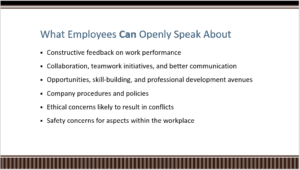
Employees can speak openly about various aspects of their coworkers and supervisors. First, employees can share constructive feedback about work performance openly with coworkers and supervisors in a professional manner. Second, they can openly communicate about collaboration efforts and teamwork initiatives. Third, they can share professional development opportunities, career goals, and skill-building activities with other employees, supervisors, and employers. Fourth, they can openly discuss company policies that govern their actions. Fifth, employees can discuss ethical concerns with three parties. Lastly, they can discuss their safety concerns within the workplace with fellow workmates, supervisors, and employers.
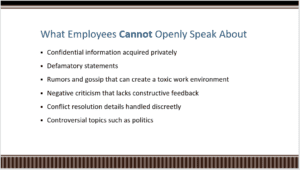
Employees should not openly discuss confidential information about coworkers and supervisors, such as personal matters, shared in confidence. Employees should not utter defamatory remarks about coworkers, supervisors, or employers, as this can damage reputations. Also, employees are not allowed to spread rumors about coworkers, supervisors, or employers, as this can create a toxic work environment and undermine morale within the team. Further, it is unacceptable for employees to criticize the work of others without offering constructive feedback that can assist in achieving improvement. It is important for discussions about ongoing conflicts with coworkers, supervisors, or employers to be handled discreetly through appropriate channels. Lastly, employees should avoid discussing sensitive topics, like politics, that could create tension within the workplace.
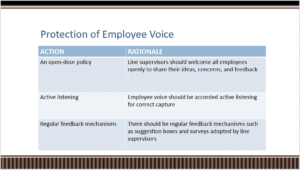
Line supervisors should maintain an open-door policy, welcoming employees to share their ideas and offer feedback without fear of retribution. Also, line supervisors should practice active listening when employees express their opinions or raise issues. Notably, this means giving full attention, acknowledging their perspectives, and asking clarifying questions to ensure understanding. Establishing regular feedback mechanisms, such as surveys and suggestion boxes, allows employees to provide feedback anonymously.
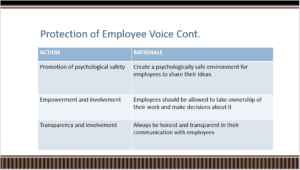
Line supervisors should embrace the well-being of employees regarding psychological safety. Notably, this can be achieved by creating a psychologically safe environment to assist employees in sharing ideas openly and safely. Supervisors should strive to be transparent and honest in their communication with employees to foster trust and understanding. Lastly, line managers should empower employees to take ownership of their work and enhance their sense of ownership and commitment to the organization. Supervisors should delegate authority and encourage employee contributions to reinforce their value and agency within the organization.
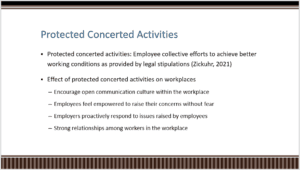
Regardless of union membership, employees have the right to participate in collective action to improve their working circumstances through protected concerted actions as defined by the National Labor Relations Act (NLRA) (Zickuhr, 2021). These actions include organizing campaigns and strikes, as well as talks among coworkers over pay, benefits, and other aspects of employment. Employees feel encouraged to voice their concerns and push for change without fear of reprisal in workplaces that respect and promote protected collective activities. Employee engagement, contentment, and productivity increase owing to the management and staff working together in an atmosphere of open communication, trust, and collaboration. It also motivates employers to deal with workplace problems early on, which builds deeper bonds and creates a more peaceful office atmosphere.
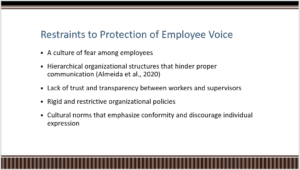
There are several reasons why there may be restrictions on the protection of employee voice at work, which can impede honest and productive discourse. A culture of fear or retaliation, when workers are reluctant to speak up out of concern about possible consequences like censure, demotion, or termination, is one important restriction. Furthermore, communication hurdles may be brought about by hierarchical organizational structures since staff members may experience marginalization or intimidation when attempting to express their thoughts to managers or supervisors (Almeida et al., 2020). A lack of trust and openness may also suppress employee voice since disenchanted or disillusioned workers may feel that their opinions are not valued or that the procedures used to make decisions need to be clarified. Furthermore, the range of permissible coordinated activities may be restricted by laws or restrictive corporate policies, which would impede workers’ ability to collectively defend their rights or solve workplace difficulties. Lastly, employee voice can be stifled by cultural or societal standards that value conformity above individual expression, which discourages disagreement and creativity.
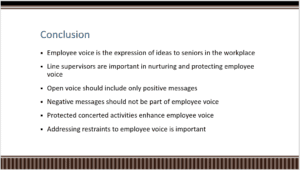
The presentation has covered important aspects related to employee voice, which refers to the means through which employees in an organization air their views to their seniors. In this regard, we have observed that line managers have a crucial role in ensuring employee voice is managed and protected within a workplace. They need to educate the employees on the nature of messages that can be considered employee voice and what should not be considered employee voice. Employee voice is protected under the “protected concerted activities,” and by considering this term, employees can gain more voice. In addition, it is crucial to address restraints on employee voice to ensure effectiveness is attained.
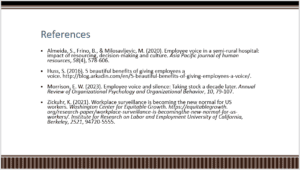
Almeida, S., Frino, B., & Milosavljevic, M. (2020). Employee voice in a semi‐rural hospital: impact of resourcing, decision‐making and culture. Asia Pacific journal of human resources, 58(4), 578-606.
Huss, S. (2016). 5 beautiful benefits of giving employees a voice. http://blog.arkadin.com/en/5-beautiful-benefits-of-giving-employees-a-voice/.
Morrison, E. W. (2023). Employee voice and silence: Taking stock a decade later. Annual Review of Organizational Psychology and Organizational Behavior, 10, 79-107.
Zickuhr, K. (2021). Workplace surveillance is becoming the new normal for US workers. Washington Center for Equitable Growth. https://equitablegrowth.org/research-paper/workplace-surveillance-is-becomingthe-new-normal-for-us-workers/. Institute for Research on Labor and Employment University of California, Berkeley, 2521, 94720-5555.
ORDER A PLAGIARISM-FREE PAPER HERE
We’ll write everything from scratch
Question 
Case Assignment
In this assignment, you have the opportunity to look at employee voice and the protections and restraints on that voice.
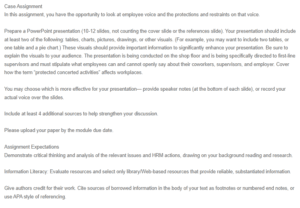
Employee Voice – Protections and Restraints
Prepare a PowerPoint presentation (10-12 slides, not counting the cover slide or the references slide). Your presentation should include at least two of the following: tables, charts, pictures, drawings, or other visuals. (For example, you may want to include two tables, or one table and a pie chart.) These visuals should provide important information to significantly enhance your presentation. Be sure to explain the visuals to your audience. The presentation is being conducted on the shop floor and is being specifically directed to first-line supervisors and must stipulate what employees can and cannot openly say about their coworkers, supervisors, and employer. Cover how the term “protected concerted activities” affects workplaces.
You may choose which is more effective for your presentation— provide speaker notes (at the bottom of each slide), or record your actual voice over the slides.
Include at least 4 additional sources to help strengthen your discussion.
Please upload your paper by the module due date.
Assignment Expectations
Demonstrate critical thinking and analysis of the relevant issues and HRM actions, drawing on your background reading and research.
Information Literacy: Evaluate resources and select only library/Web-based resources that provide reliable, substantiated information.
Give authors credit for their work. Cite sources of borrowed information in the body of your text as footnotes or numbered end notes, or use APA style of referencing.